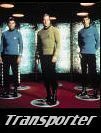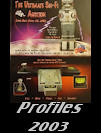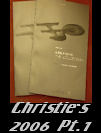I came across this fascinating article several years ago, which offers a rare glimpse into the creative mind of William Ware Theiss - the designer of all the Starfleet uniforms and alien costumes seen in the 79 episodes of The Original Series. His elegant, daring and revealing wardrobe creations for the female guest stars on the series is one of the most memorable and iconic aspects of TOS. This rarely seen article was written in 1988 - just 4 years before Mr. Theiss passed away. It is reproduced below in its entirety ...
Bill Theiss:
The Lost Interview
A STITCH IN TIMEby
James Magda
On December 10, 1992 Star Trek costume designer William Ware Theiss died of complications resulting from the AIDS virus. Theiss was a very private man. In researching this piece, very little information could be found on him or his work, a fact he readily admitted: “I don’t give a lot of interviews.” Nonetheless, in 1988 he went out of his way to talk about himself and his work for this never-before-published article.
Ask the average, catchpenny costume designer to come up with a sexy outfit for a leading lady and what will you get? Oh sure, the resulting garment will probably be attractive enough, but the features will most likely be the standard fare coming out of Hollywood these days: plunging necklines, slit skirts and/or bared backs.But give William Ware Theiss the same order and watch the word "intriguing" take on a whole new meaning. While the traditionally exposed areas are certainly not unattractive, the Theiss signature is to uncover seemingly sexless areas, be it on male or female flesh. "The side of an arm or the front of a thigh can be effectively titillating, considering they're not body parts you're used to seeing made naked," Theiss says. Not exactly an idea a novice couturier might have thought of, but then this designer has been plying his trade for a while. Says Theiss: "You have to learn all the rules before you can break them."
From wardrobe man to costume designer, Bill Theiss' talents have been utilized in television series such as The Donna Reed Show, The Dick Van Dyke Show and My Favorite Martian, to name only a few. His big screen credits include “Bound For Glory,” “Butch and Sundance: The Early Days,” “Heart Like A Wheel” (all Oscar-nominated for "Best Costume") and many others. But to science fiction fans, the job he is most noted for is that of costume designer for both Star Trek and now Star Trek: The Next Generation. The latter of which he won the 1988 Peabody Award for "Outstanding Costume Design" for the episode "The Big Goodbye."
Theiss first became associated with Star Trek nearly a quarter of a century ago. Costumes he had designed for "The Veldt," a one-act play from "The World of Ray Bradbury," were receiving a great deal of positive attention when a friend of his brought her boss to see what all the commotion was about. The friend was Dorothy (D.C.) Fontana, and her boss, of course, was Gene Roddenberry.
Roddenberry was trying to get a long-shot pilot off the ground called Star Trek.Although Roddenberry had interviewed several people to fill the slot of costume designer already, he was very taken with Theiss and his work. The two hit it off on a personal level immediately and soon Theiss found himself immersed in the world of Star Trek.
After the none-too-easy task of creating the "classic Trek" Starfleet uniforms, Theiss started in on the exotic (and sometimes erotic) guests' costumes. During the show's three-season run, he clothed everything from blue-skinned Andorians to Vulcan ambassadors. But how does one come up with outfits for aliens and cultures that don't yet exist? Does he listen to NASA or futurists' suggestions about clothing? "No, not really. There's no way of predicting clothes of the future, so I'm lying, basically, with my designs," Theiss says. "As convincing, fun and stimulating a lie as I can tell, but still a lie."
"As for where I get my ideas from . . . well, I don't get them from my dreams or anything. Mainly, I get them from fabric that I see that's available; I look for interesting patterns in the material itself." The velour tunics from Star Trek's first and second seasons are a good case in point. Theiss felt the material would look particularly attractive under the bright studio lights. Unfortunately, velour has an inherent drawback: it shrinks every time it's cleaned. (That explains the "shorty" look of all the men's uniform tops during seasons one and two. And you thought they were meant to look that way.) Thus, by the third season all the tunics and skirts were reconstructed of a double-knit material instead.
Another quirk involving the original series’ tunics were the colors - in particular, “command.” Trekkies everywhere will swear Spock wore blue, Scotty wore red and Kirk wore gold. Wrong. The three Starfleet colors were blue, red and green. Lime green, to be exact. “It was one of those film stock things;” Theiss states, “it photographed one way - burnt orange or a gold. But in reality was another; the command shirts were definitely green.” As further proof, look at the wrap-around tunics as well as the dress uniform tunics of Kirk’s – all green. They came off as their true colors because they were constructed of different materials than the standard duty command shirts.
This same film problem can be seen in other areas of the old show as well. The miniature of the Enterprise alternately looked light gray, pale blue and sometimes faint green. The carpet on the bridge, which was actually a dark gray, often appeared tan or brown. So, for the devoted fan trying to faithfully recreate his little corner of Trekdom for an upcoming convention costume contest, what does he do? Adhere to what actually was, the intended look, the look the cast and crew all saw? Or go with what we all saw on our screens each episode? Decisions, decisions.
Examples of other fabrics Theiss chose for being “interesting” can be seen in the Klingon vests (this fabric was also used for the gown-like sashes of the Eminiar VII councilmen in “A Taste of Armageddon”), the Klingon pants, the Romulan uniforms (a woven, shawl-like material) and even the environmental suits (made of vinyl shower curtains!) worn by Mr. Spock and Joe Tormolen in “The Naked Time.”
Not all of the designer's intriguing ideas have been just for Star Trek, though. After the original Trek was cancelled, Theiss added 15 or so motion pictures to his repertoire. In the 1971 film “Pretty Maids All In A Row” (produced by Gene Roddenberry), Angie Dickinson wore a Theiss design that was actually a lace tablecloth with a bow tied on each shoulder. In a seduction scene, she was to pull off one of the bows and down it would come. "It was during the hippies and all that. Everyone was making clothes out of all sorts of things," he says. The 1978 sleeper “Goin' South” was another feature Theiss worked on, preferring period pieces to contemporary films because they are simply "more interesting to design for." Eschewing the spit and polish of a Bonanza-type wardrobe, Theiss opted for a grittier, more realistic version of the old west.
It was after serving for two years with The Disney Sunday Movie as costume designer that he received a call asking him to beam aboard the Enterprise yet again. Once charged with creating new Starfleet uniforms for Star Trek: The Next Generation, Theiss drew from the original series, rather than the movies, as a jumping off point because he feels clothing is, even now, moving toward a less structured look. "They’re made of jumbo-weight spandex; the material swimwear is made from," says Theiss. "But I use the inside of the fabric, the dull side, as the garment’s top. They're a simple, uncomplicated design. I try not to make my designs too complex, visually. Simpler is more effective."
The new uniforms are basically a skin-tight, one-piece jumpsuit. (Ironically, in the 1960s Roddenberry rejected NASA’s suggestions of what future space explorers would wear, calling it “long underwear.”) With only a zigzag of color up top over a black bottom half, the design idea is to not only draw attention to the actors’ faces for dramatic reasons, but to also hide a multitude of sins below, such as plump bellies and love handles. The “zigzags” are vocationally color coded: wine for command, teal blue for medical and sciences, and mustard for engineering, security and everything else. The insignia/communicators attach to the chest via Velcro™ for easy removal when the uniforms are sent to the cleaners. Up near the neck are the rank insignias, or "pips."
"The rank on the old show was a braid we had custom-made and was based on our current naval ranking," says Theiss. "But the new rank are these little gold circles, and black circles with a gold rim."Although stated in some fan-published magazines as otherwise, the ranking order according to the official Next Generation uniform designer is as follows:
One black pip = Chief Warrant Officer
One gold pip = Ensign
One gold + one black pip = Lieutenant, Junior Grade
Two gold pips = Lieutenant
Two gold + one black pip = Lieutenant Commander
Three gold pips = Commander
Four gold pips = Captain
Invisible zippers are once again used in fastening the Starfleet uniforms. However, instead of running along the left shoulder and collar as in the original series, the zippers now run down the center front.
The standard duty Next Generation uniforms evolved through repeated meetings with Theiss and the show's producers, with models sometimes displaying the designer's ideas. The producers would offer their suggestions and Theiss would counter with his own. Ultimately though, the majority of design elements were Theiss' alone. (One uniform idea he suggested was a type of jumpsuit with the sides out from the waist up. As fascinating as that might have been, the idea was obviously rejected.)
Unlike the bulky, hot-looking uniforms from the features, Theiss' Next Generation uniforms look completely comfortable enough to work an eight-hour starship shift in. "Bob Fletcher [designer of the feature uniforms] is a very fine designer, and I mean that very sincerely," says Theiss. "We don't design the same way and there's no reason we should -- or could. It's apples and oranges. But my personal feeling is if you go to a structured, woven fabric and do the kind of tailoring and structuring he's done, it puts those costumes back, historically, 500 years, with shoulder seams and shoulder pads of that type."
Unlike most episodic television, Star Trek: The Next Generation can't rely on conventional clothes like business suits or blue jeans. Each week's wardrobe must look like nothing ever seen before, but still be interesting and believable. The flip side of this coin is that the costumes can't be so fascinating as to take the viewers' attention away from the story. "Sometimes a show will call for 30 or 40 costumes," Theiss says, "And since we film back to back, that means I have to design, get approval from the producers and director, and construct the costumes in six to eight days."
But don't get the idea that Theiss is somewhere sitting in front of a sewing machine, watching the clock. "I don't even know how to sew," he laughs. "I intentionally never learned."
Even though the show is currently on hiatus, several behind-the-scenes personnel stay a few days later and return a few days earlier than the rest of the cast and crew. They’re gearing up for the show’s second season, scheduled to start filming June 9 (writers’ strike permitting).
Second seasons usually mean a little more money in the budget, and Theiss hopes some of this surplus will find its way to the wardrobe department. In the planning stages are more coveralls, more civilian clothing, and perhaps more skirts for the women and men. "Having the actresses and actors both in skirts was to diffuse any sexist accusations that might have been associated with designs from the old show. It's also fashionably probable 400 years from now that men would wear skants. Even so, there was usually a problem on the set," he admits, "because some wisecracks were always made." Theiss emphasizes that he wants the wearers of his creations to be at ease with what he designs. "I won't force an actor or actress to wear something they're not at least 80 percent comfortable with."
So far in ST:TNG, some of the more enticing designs have been the crisscrossing harem girl outfit worn by Tasha Yar (Denise Crosby) in "The Naked Now," and the chest baring costume worn by Commander Riker (Jonathan Frakes) in "Angel One." Both costumes revealed bodies in ways not usually seen, and were quite effective at being stimulating and believable. But not both actors were equally comfortable wearing them. "Denise has a terrific body and was comfortable exposing it to a degree," Theiss reveals. "She had no problem with her costume."Jonathan Frakes, on the other hand, was a bit uneasy with his outfit for "Angel One." It consisted of baggy leggings wrapped strategically with thongs, and a loose, glittery tunic that exposed one side of his chest. It was meant to be revealing and exploitative, and that is exactly how it made Frakes feel -- revealed and exploited. "But that was fine, because as Riker, he was supposed to be uncomfortable with the outfit," says Theiss. "And Jonathan is enough of a professional that he used his own uneasiness to his character's advantage. That episode was really tough to design for."
When it comes to choosing a favorite from all the costumes he has created for both Treks, Theiss is hard pressed to single out any one design. "The gown for Leslie Parrish in `Who Mourns For Adonais?' seems to get a lot of attention," he says. "Other than that, I don't know. Michelle Phillips' outfit in `We'll Always Have Paris' is quite sensational; and Denise Crosby's punk-of-the-future costume from the sewer scene in `Where No One Has Gone Before' is good." The problem is that a lot of my work is seen on screen for only two to three seconds, and even then it might be in a bad light or angle. Like Commander K'Nera's uniform in `Heart of Glory.' I was very proud of that. But between the lighting, camera position and special effects, you hardly saw it. But then, you can't really justify taking two hours to light and block a scene just to showcase a costume." The play's the thing, according to Theiss. "That's what it's really all about. It's not about the costumes."
One costume he won’t have to worry about lighting and blocking next season is that of Denise Crosby, who has left the show. “Denise felt that what she was doing wasn’t challenging enough,” says Theiss. “She won’t be replaced; Worf (Michael Dorn) will take over her responsibilities. The producers were pretty unhappy about her leaving, but they didn’t want to keep her in bondage or anything, so they let her go.”
As most Trek fans are well aware, the original series’ cast and crew speak often of the infamous "family feeling" on the old Star Trek set. But did this feeling actually exist, or are selective memories just working overtime? "No, there was a feeling of family on the old set," Theiss recalls. "But there was also a certain amount of . . . let's say, `class distinction.' And a certain amount of a lack of respect between departments. "But the guys on the show now -- they're equally as good on a nuts-and-bolts level -- but they also have a spirit and a . . . style missing from the old crew."
Considering Hollywood’s unwritten dictum of “now you work, now you don’t,” has Theiss ever considered a safer, less volatile profession? "I was once approached to design a line of motorcycle outfits," he confesses. "But the project never materialized. Plus, it didn't seem an appropriate thing to do at the time. I would enjoy possibly designing clothing in a futuristic vein. Perhaps formal wear, evening gowns -- that sort of thing would be fun." So, can The Next Generation’s producers, as well as its fans, expect him to be around for the duration? “The pace of a weekly series is very demanding, and even more so with Star Trek,” William Ware Theiss declares. “But as long as I enjoy it, and as long as they want me, I’ll be around.”



























































































